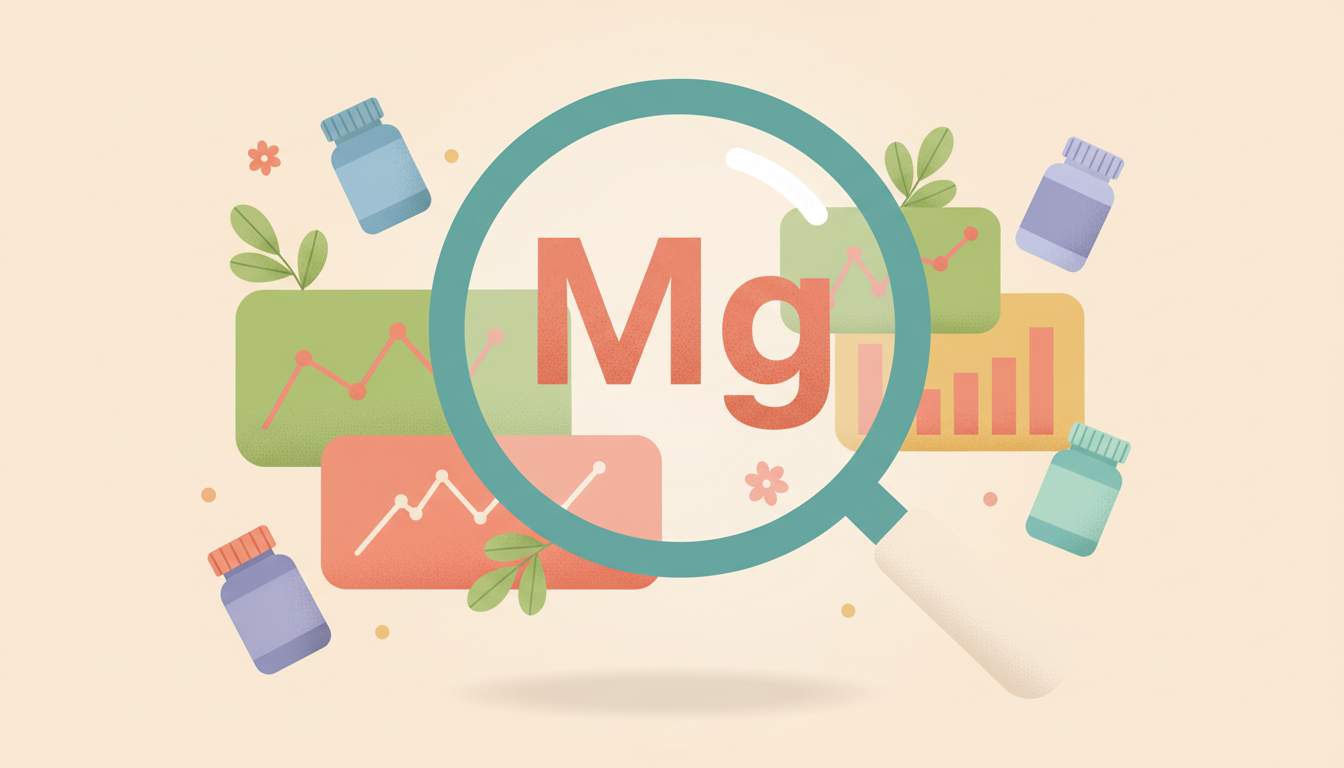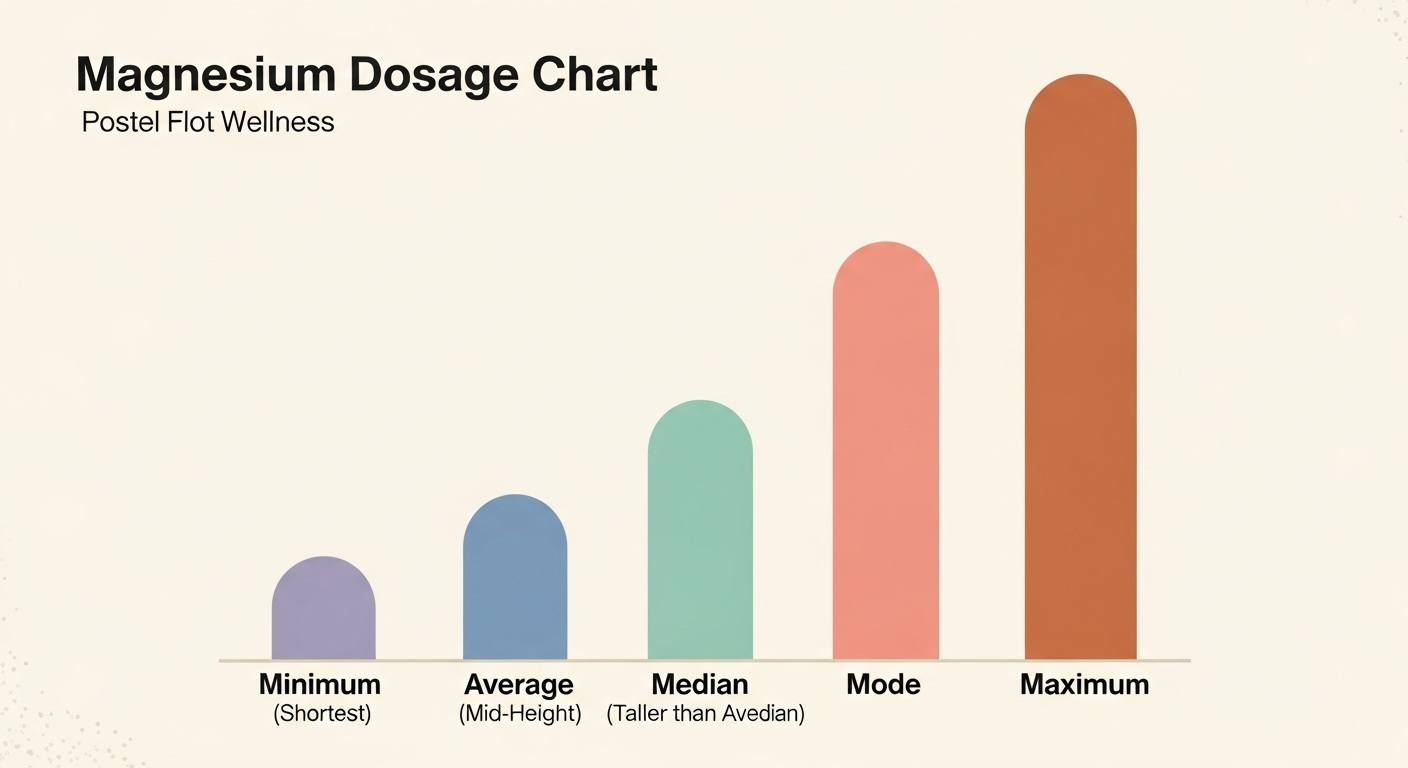Magnesium by the Numbers: A Statistical Analysis of Today's Supplements
Magnesium by the Numbers: A Statistical Analysis of Today's Supplements

A Data-Driven Overview of Magnesium Supplements

Magnesium is a vital mineral, but navigating the supplement aisle can be overwhelming. To cut through the marketing claims, we conducted a purely statistical analysis of the magnesium supplement market. This article breaks down the numbers behind the products to help you understand what you're really buying.
Here’s what we'll cover:
- The Data: An overview of the 250 products that form the basis of this analysis.
- Popular Forms: Which chemical forms of magnesium, like citrate or glycinate, are most common.
- Dosage Trends: The average, most frequent, and range of magnesium dosages per serving.
- Delivery Methods: A look at whether capsules, powders, or tablets dominate the market.
- Common Ingredients: What other vitamins and minerals are most often paired with magnesium.
- Cost Analysis: A breakdown of the average price per bottle, per serving, and per milligram to assess value.
About Our Dataset
This analysis is based on a comprehensive dataset of 250 distinct magnesium-containing supplements available on the market. Our team regularly updates this dataset to ensure the information is current and accurately reflects industry trends. The statistics, averages, and percentages in this article are derived exclusively from this product list, providing a precise snapshot as of our latest update. Of the 250 products reviewed, 198 were identified as specific magnesium supplements or multivitamins with a significant magnesium component, and these form the core of our analysis.
Our data is dynamic. We periodically refresh our product catalog, so the numbers in this analysis may change over time to reflect the latest market offerings and scientific advancements.
Ingredient Deep Dive: The Most Common Magnesium Forms

Magnesium is always bound to another molecule to form a stable compound, and the type of molecule affects its absorption and use in the body. Our analysis of 198 products revealed a clear hierarchy of popular forms.
Magnesium citrate is the most frequently used form, appearing in 31% of the supplements we analyzed. It's known for its good bioavailability and is often used to support regular bowel movements. Following closely is magnesium oxide, found in 27% of products. While it contains a high concentration of elemental magnesium, its bioavailability is generally considered lower than other forms. Magnesium glycinate (or bisglycinate), a form chelated with the amino acid glycine, is present in 17% of supplements and is often chosen for its calming properties and high absorption without a laxative effect.
Other Notable Forms and Blends
Beyond the top three, several other forms make a notable appearance. Magnesium aspartate (12%), magnesium malate (9%), and magnesium taurate (6%) are also utilized, often for their purported benefits in energy production and cardiovascular health. A significant portion of the market, approximately 23% of products, opts for a blended approach, combining two or more forms of magnesium in a single formula. These blends, like a mix of oxide, citrate, and aspartate, aim to provide a broader spectrum of benefits.
Product Format: Capsules Dominate the Market
When it comes to how consumers take their magnesium, manufacturers show a clear preference for encapsulation. Based on our data, capsules (including veggie caps and softgels) represent a commanding 45% of the market. This format is popular for its convenience and ability to mask the taste of ingredients.
Tablets are the second most common delivery system, making up 34% of the products analyzed. They are often more cost-effective to produce and can hold a higher dose in a smaller size. Powders and liquids, which offer flexible dosing and may be easier for individuals who dislike swallowing pills, account for a combined 18% of the market. Other formats like gummies or single-serving packs are far less common, representing the remaining 3%.
Dosage Analysis: A Look at Magnesium Per Serving

The amount of elemental magnesium per serving varies dramatically across products. The average dosage in our dataset is 330 mg. However, the median dosage is slightly higher at 350 mg, indicating that the majority of products cluster around this amount.
The most common dose offered is 400 mg per serving, which aligns with the higher end of daily recommendations for adults. The range is incredibly wide, starting from a low of just 5 mg in some complex formulas to a high of 800 mg in a potent, standalone supplement. This vast range underscores the importance of reading labels carefully to match a product's dosage with your specific health needs.
Common Pairings: What Else is in Magnesium Supplements?

Magnesium is rarely the only ingredient in a supplement bottle. Manufacturers often include other vitamins and minerals to enhance absorption or provide synergistic effects. Our analysis revealed a few key partners that appear frequently.
Zinc is the most common co-ingredient, found in 29% of the magnesium-containing products we reviewed. This pairing is popular in formulas aimed at immune support and hormonal health. Calcium is the second most frequent companion, present in 23% of supplements, often in products targeting bone health. Vitamin D3 (17%) and Vitamin B6 (16%) are also very common, as both are believed to play a role in magnesium's absorption and utilization within the body. A less common but notable pairing is L-Theanine (3%), typically found in formulas designed for relaxation and sleep support.
Price per 100mg is a powerful tool for comparison. A cheaper bottle isn't always better value if it contains a much lower dosage or a less bioavailable form of magnesium.
Frequently Asked Questions
There is no single "best" form; it depends on your individual needs and goals. For general supplementation, forms with higher bioavailability like citrate, glycinate, malate, and aspartate are often recommended over magnesium oxide. For instance, magnesium glycinate is known for being gentle on the stomach and promoting relaxation, while magnesium citrate can have a mild laxative effect, which may be beneficial for some.
Magnesium is a cofactor in over 300 enzyme systems that regulate diverse biochemical reactions in the body. Its key roles include supporting muscle and nerve function, maintaining a steady heartbeat, contributing to bone health, and regulating blood glucose levels. It also plays a critical part in energy production and stress management.
Evidence suggests that magnesium plays a key role in regulating the nervous system and can have a calming effect. It helps maintain healthy levels of GABA, a neurotransmitter that promotes sleep and reduces neuronal excitability. For this reason, many people supplement with magnesium in the evening to help manage stress, relax, and improve sleep quality. Forms like magnesium glycinate and L-threonate are particularly popular for neurological and cognitive support.
The most important value to look for is the amount of "elemental magnesium" per serving, which is the actual amount of magnesium available to your body. Also, check the "form" of magnesium (e.g., citrate, glycinate) to understand its properties. Finally, look at the "other ingredients" list for any unwanted fillers, allergens, or artificial additives.
Summary of Key Statistics
Our analysis of 250 magnesium supplements provides a clear, data-backed picture of the market. Here are the key takeaways:
- Most Common Form: Magnesium Citrate is the most frequently included form, appearing in 31% of analyzed products.
- Dominant Format: Capsules are the market leader, accounting for 45% of all magnesium supplements.
- Typical Dose: The average serving contains 330 mg of elemental magnesium, with 400 mg being the most common dosage.
- Top Pairings: Zinc (29%), Calcium (23%), and Vitamin D3 (17%) are the ingredients most often formulated alongside magnesium.
- Pricing Insights: The median cost per serving is $0.45. Evaluating the cost per 100 mg of elemental magnesium is the best way to compare the true value between different products.
Sources
- Magnesium in Prevention and Therapy (2015) — link [Journal Article]
source-1 - The Importance of Magnesium in Clinical Healthcare (2017) — link [Journal Article]
source-2 - The Role of Magnesium in Neurological Disorders (2018) — link [Journal Article]
source-3 - Bioavailability of magnesium compounds: a narrative review (2021) — link [Journal Article]
source-4 - Magnesium Status and Stress: The Vicious Circle Concept Revisited (2011) — link [Book Chapter]
source-5